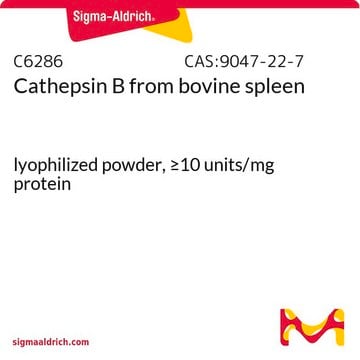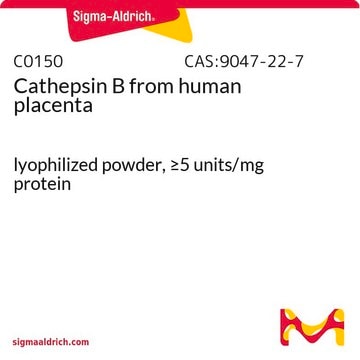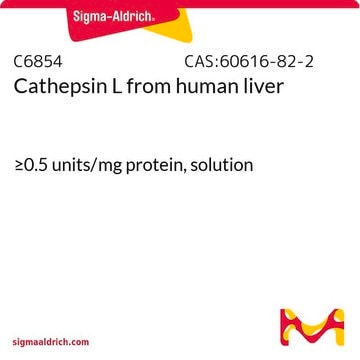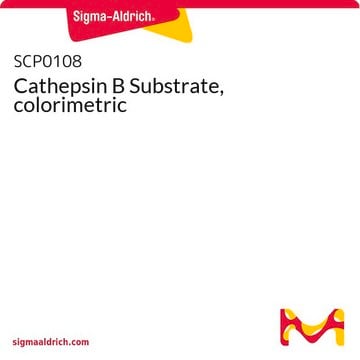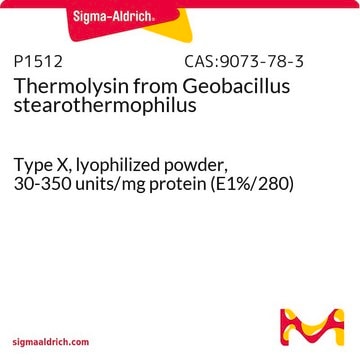C8511
Cathepsin C from bovine spleen
Type X, lyophilized powder, ≥5 units/mg protein
Sinonimo/i:
Dipeptidyl aminopeptidase, Dipeptidyl peptidase I
About This Item
Prodotti consigliati
Origine biologica
bovine spleen
Tipo
Type X
Saggio
>25% protein (biuret)
Forma fisica
lyophilized powder
Attività specifica
≥5 units/mg protein
Composizione
Protein, ≥25% biuret
Produttore/marchio commerciale
Sigma-Aldrich
Condizioni di stoccaggio
OK to freeze (Unstable. Keep frozen)
Concentrazione
≥5 unit/mg protein
tecniche
activity assay: suitable
Compatibilità
suitable for molecular biology
applicazioni
life science and biopharma
Condizioni di spedizione
dry ice
Temperatura di conservazione
−20°C
Informazioni sul gene
cow ... CTSC(352958)
Categorie correlate
Descrizione generale
Dipeptidyl peptidase I (DPPI), also known as cathepsin C, is an abundant lysosomal cysteine protease from the papain superfamily with a molecular weight of approximately 200 kDa. It is widely expressed in a variety of mammalian tissues, with the highest levels found in the lungs, kidneys, liver, and spleen, and relatively lower levels in the brain.
DPPI is the only member of its family that is functional as a tetramer, consisting of four identical subunits, each composed of an N-terminal fragment, a heavy chain, and a light chain. It is identified as one of the multifaceted protease-processing machines, having been shown to function beyond its role as a non-specific lysosomal protease.
Applicazioni
Azioni biochim/fisiol
Cat C participates in neutrophil recruitment and production of chemokines and cytokines in many inflammatory diseases. Cathepsin C plays a crucial role as an essential enzyme in activating granule serine proteases in cytotoxic T lymphocytes, natural killer cells (granzymes A and B), mast cells (chymase and tryptase), and neutrophils (cathepsin G, proteinase 3, and elastase).
Avvertenza
Definizione di unità
Stato fisico
Substrato
Codice della classe di stoccaggio
11 - Combustible Solids
Classe di pericolosità dell'acqua (WGK)
WGK 3
Punto d’infiammabilità (°F)
Not applicable
Punto d’infiammabilità (°C)
Not applicable
Dispositivi di protezione individuale
Eyeshields, Gloves, type N95 (US)
Certificati d'analisi (COA)
Cerca il Certificati d'analisi (COA) digitando il numero di lotto/batch corrispondente. I numeri di lotto o di batch sono stampati sull'etichetta dei prodotti dopo la parola ‘Lotto’ o ‘Batch’.
Possiedi già questo prodotto?
I documenti relativi ai prodotti acquistati recentemente sono disponibili nell’Archivio dei documenti.
I clienti hanno visto anche
Il team dei nostri ricercatori vanta grande esperienza in tutte le aree della ricerca quali Life Science, scienza dei materiali, sintesi chimica, cromatografia, discipline analitiche, ecc..
Contatta l'Assistenza Tecnica.